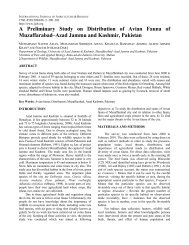44 ZULFIQAR ALI and MUHAMMAD AKHTARForktail 21 (2005)Table 1. W<strong>at</strong>erbirds recorded <strong>at</strong> 16 sites <strong>in</strong> <strong>Punjab</strong>, <strong>Pakistan</strong>.Site Observ<strong>at</strong>ion po<strong>in</strong>ts White-headed Duck Other w<strong>at</strong>erbirdsCoord<strong>in</strong><strong>at</strong>esAltitude (m)D<strong>at</strong>e of survey(2003)Rawal lake 33 o 41’E 73 o 07’N 530 28 Jan 7 6 (1987) 1902 30% 62 3,089Kallar Kahar lake 32 o 46’E 72 o 42’N 641 28 Jan 0 90 (1972) 220 30% 91 1,246Shahpur (Jehlum bridge) 32 o 18’E 72 o 24’N 175 29 Jan 0 5 (1930) 1350 60% 93 1,248Jahlar lake 32 o 30’E 72 o 54’N 824 29 Jan 2 148 (1994) 100 40% 53 370Khabbaki lake 32 o 37’E 72 o 13’N 745 29 Jan 0 1,005 (1968) 283 100% 130 342Ucchali lake 32 o 33’E 72 o 25’N 760 29 Jan 22 667 (1987) 943 60% 103 1,591Nammal lake 32 o 41’E 71 o 48’N 340 29 Jan 2 400 (1970) 486 50% 115 1,726Rangpur lake 32 o 10’E 71 o 50’N 180 30 Jan 0 2 (1993) 1,250 0% 110 9,256Chashma barrage (Mianwali) 32 o 31’E 71 o 29’N 200 30 Jan 0 1 (1922) 33,109 0% 126 71,008Kharar lake 30 o 53’E 73 o 32’N 165 05 Feb 0 700 (1975) 235 100% 23 382Khangarh lake 29 o 52’E 71 o 67’N 100 06 Feb 0 1 (1883) 100 80% 35 257Sulmanki headworks (Bahawalnagar) 30 o 22’E 73 o 52’N 177 7 Feb 0 6 (1922) 1150 70% 85 5,821Chalianwala 32 o 37’E 73 o 38’N 235 19 Feb 0 11 (1931) 23 95% 30 90Qadirabad headworks (Hafizabad) 32 o 19’E 73 o 41’N 211 20 Feb 0 1 (1911) 2,850 20% 101 9,711Marala headworks (Sialkot) 32 o 40’E 74 o 28’N 242 20 Feb 0 1 (1891) 1650 10% 92 8,059Jassar (River Ravi) 32 o 31’E 74 o 59’N 334 21 Feb 0 70 (1987) 1125 70% 91 4,588Total 33 1,039 (1968) 46,746 51% 149 118,784No.Previous max.no. (year)Area (ha)Reduction <strong>in</strong> area1990–2003No. speciesrecordedNo. <strong>in</strong>dividualsrecordedMundkur 2003).These impacts are likely to be exacerb<strong>at</strong>edby the effects of global clim<strong>at</strong>e change.In <strong>Pakistan</strong>, 889 were counted <strong>in</strong> 1987–1988, butnumbers have decl<strong>in</strong>ed substantially s<strong>in</strong>ce then, andfewer than 50 have been recorded s<strong>in</strong>ce 1995–1996(Chaudhry et al. 1997). S<strong>in</strong>ce the l<strong>at</strong>e 1980s, WhiteheadedDuck have been known to w<strong>in</strong>ter <strong>in</strong> <strong>Pakistan</strong>only <strong>at</strong> Ucchali, Khabbaki and Jahlar (known collectivelyas Ucchali <strong>wetlands</strong> complex, a Ramsar site s<strong>in</strong>ce1996). It is not clear, however, whether the lack ofsight<strong>in</strong>gs elsewhere is because the birds are absent orbecause of <strong>in</strong>adequ<strong>at</strong>e <strong>surveys</strong>.The goal of this survey, therefore, was to look forthis species and assess its st<strong>at</strong>us <strong>at</strong> the 16 sites <strong>in</strong><strong>Punjab</strong> where it had been recorded s<strong>in</strong>ce the 1880s:Rawal lake, Kallar Kahar lake, Shahpur (Jehlumbridge), Jahlar lake, Khabbaki lake, Uchalli lake,Nammal lake, Rangpur lake, Mianwali (Chashmabarrage), Kharar lake, Khangarh lake, Bahawalnagar(Sulmanki headworks), Chalianwala, Hafizabad(Qadrabad headworks), Sialkot (Marala headworks)and Jassar (River Ravi) (Fig. 1; Appendix 1).METHODSObserv<strong>at</strong>ions were made, usually for a full day, <strong>at</strong> eachof the 16 sites, between 28 January and 21 February2003. Up to five po<strong>in</strong>ts per site were selected fromwhich the whole site could be observed. At each po<strong>in</strong>t,birds were counted us<strong>in</strong>g a telescope before mov<strong>in</strong>g tothe next po<strong>in</strong>t as rapidly as possible without disturb<strong>in</strong>gthe birds. <strong>Bird</strong>s were identified us<strong>in</strong>g Grimmett et al.(2001). The surface area of w<strong>at</strong>er <strong>at</strong> each site wascalcul<strong>at</strong>ed from a map plotted us<strong>in</strong>g coord<strong>in</strong><strong>at</strong>esrecorded with a Magellan GPS; then the % reductions<strong>in</strong>ce 1990 (IUCN 1990) was calcul<strong>at</strong>ed.RESULTSIn total, 118,784 <strong>in</strong>dividuals of 149 species werecounted <strong>at</strong> the 16 sites (Table 1; Appendix 2).Chashma lake, Qadirabad headworks, Rangpur lake,Marala headworks, Sulmanki headworks, Jassar (Raviriver) and Rawal lake had the highest numbers of<strong>in</strong>dividuals. A total of 33 White-headed Ducks werecounted <strong>at</strong> four sites: Ucchali (22 <strong>in</strong>dividuals), Jahlar(two), Nammal (two) and Rawal lake (seven).The highest numbers of species were <strong>at</strong> Chashma(126 species), Nammal (115), Rangpur (110), andUcchali (103) lakes. The ten most abundant specieswere: Eurasian Coot Fulica <strong>at</strong>ra, Common PochardAythya fer<strong>in</strong>a, Northern P<strong>in</strong>tail Anas acuta, GadwallAnas strepera, Little Grebe Tachybaptus ruficollis,Mallard Anas pl<strong>at</strong>yrhynchos, Northern Shoveler Anasclype<strong>at</strong>a,W<strong>at</strong>er Rail Rallus aqu<strong>at</strong>icus, Black-w<strong>in</strong>ged StiltHimantopus himantopus and Red-w<strong>at</strong>tled Lapw<strong>in</strong>gVanellus <strong>in</strong>dicus.White-headed Ducks were recorded only <strong>at</strong>Ucchali, Jahlar, Nammal and Rawal lakes, and wereabsent from all other sites from which the species wasknown historically. Many sites had significantlyreduced w<strong>at</strong>er surface areas compared to d<strong>at</strong>apresented <strong>in</strong> IUCN (1990), with an overall reduction<strong>at</strong> all sites comb<strong>in</strong>ed of 51%. Khabbaki, Kharrar,Chalianwala and Khangarh had all suffered 80–100%reductions <strong>in</strong> area s<strong>in</strong>ce the 1990 figures. The likelycauses of these shr<strong>in</strong>kages <strong>in</strong>clude ground w<strong>at</strong>erextraction, development of barrages and canal systems.
Forktail 21 (2005) <strong>Bird</strong> <strong>surveys</strong> <strong>at</strong> <strong>wetlands</strong> <strong>in</strong> <strong>Punjab</strong>, <strong>Pakistan</strong>45RECOMMENDATIONSThere is an urgent need to ensure the ma<strong>in</strong>tenance andimprovement of the habit<strong>at</strong> conditions for WhiteheadedDuck <strong>at</strong> the sites where the species wasrecorded. This will require the government, n<strong>at</strong>ureconserv<strong>at</strong>ion <strong>in</strong>stitutions and other agencies to worktogether collabor<strong>at</strong>ively to conserve the rema<strong>in</strong><strong>in</strong>gpopul<strong>at</strong>ions. Specifically: (1) a task-force from governmentand non-government sectors should beconstituted to study the popul<strong>at</strong>ion dynamics of migr<strong>at</strong>oryw<strong>at</strong>erbirds <strong>in</strong> these areas; (2) detailed hydrologicalobserv<strong>at</strong>ions of w<strong>at</strong>er <strong>in</strong>flow and outflow, retentioncapacity, loss through evapotranspir<strong>at</strong>ion, manipul<strong>at</strong>ionof w<strong>at</strong>er level, silt load and its impact onveget<strong>at</strong>ion etc. should be recorded; (3) pollution levelsshould regularly be monitored with a special emphasison phosphorus and nitrogen cycl<strong>in</strong>g, one of the pr<strong>in</strong>cipalfactors responsible for degrad<strong>at</strong>ion of w<strong>at</strong>er quality<strong>in</strong> <strong>wetlands</strong>; (4) w<strong>at</strong>er levels should be managed tobenefit w<strong>at</strong>erbirds; and (5) some sites should beconsidered as closed areas for w<strong>at</strong>erbirds, with disturbanceby local people and c<strong>at</strong>tle prohibited.ACKNOWLEDGMENTSInspir<strong>at</strong>ion for this survey came from a recent report by WetlandsIntern<strong>at</strong>ional on White-headed Duck <strong>in</strong> Central Asia. Fund<strong>in</strong>g andlogistical support was provided by WWF-<strong>Pakistan</strong>. In particular wewould like to thank Ali Hassan Habib and Richard Garstang for theirassistance, encouragement and adventure they offered me. RichardGarstang’s cont<strong>in</strong>uous support and guidance provided much-neededhelp. We are gr<strong>at</strong>eful to Muhammad Akhtar for his encouragement.We would like to express our gr<strong>at</strong>itude to Ornithological Society of<strong>Pakistan</strong> (OSP) and Wildlife and Parks Department, <strong>Punjab</strong>(WPWD) which were partners <strong>in</strong> this survey. Among many peoplewhom we wish to thank are: Aleem Ahmad Khan (OSP), Agha Azaz,Anwar Mann Muhammad Afzal (WPWD), Salman Ashraf, AnwarNaseem, Waqar Naseem and Bishar<strong>at</strong> Naz (WWF-<strong>Pakistan</strong>). Ourappreci<strong>at</strong>ion is also due to all our survey participants for theirgenerous assistance. Wali Khan and Mr Asm<strong>at</strong> were not only gooddrivers but were also helpful dur<strong>in</strong>g the field <strong>surveys</strong>.REFERENCESBailey, F. M. (1916) Occurrence of the White-headed or Stiff-tailDuck (Erism<strong>at</strong>ura leucocephala) <strong>in</strong> the Koh<strong>at</strong> district. J. BombayN<strong>at</strong>. Hist. Soc. 24: 599.Baker, E. C. S. (1908) Indian ducks and their allies. Bombay: BombayN<strong>at</strong>ural History Society.Barton, F. J. H. (1902) The occurrence of the white-faced stiff tailduck <strong>at</strong> Mardan. J. Bombay N<strong>at</strong>. Hist. Soc. 14: 375.<strong>Bird</strong>Life Intern<strong>at</strong>ional (2001) Thre<strong>at</strong>ened birds of Asia: the <strong>Bird</strong>LifeIntern<strong>at</strong>ional Red D<strong>at</strong>a Book. Cambridge, U.K.: <strong>Bird</strong>LifeIntern<strong>at</strong>ional.<strong>Bird</strong>Life Intern<strong>at</strong>ional (2004) Thre<strong>at</strong>ened birds of the world 2004. CD-ROM. Cambridge, U.K.: <strong>Bird</strong>Life Intern<strong>at</strong>ional.Bolster, R. C. (1923) On the habits of the White-headed Duck(Oxyura leucocephala). J. Bombay N<strong>at</strong>. Hist. Soc. 29: 284–285.Boomford, T. (1887) Letter about Stiff-tailed Duck. Stray Fe<strong>at</strong>hers10: 521.Chaudhry, A. A. (1992) Habit<strong>at</strong> changes thre<strong>at</strong>en the White-headedDuck <strong>in</strong> <strong>Punjab</strong>, <strong>Pakistan</strong>. Thre<strong>at</strong>ened W<strong>at</strong>erfowl Specialist GroupNews 2: 5–6Chaudhry, A. A., Gill. A. H. and Ali, Z. (1997) Conserv<strong>at</strong>ion of WhiteheadedDuck <strong>in</strong> the Salt Range lakes (Ucchali Complex), <strong>Punjab</strong>,<strong>Pakistan</strong>. Faisalabad: <strong>Punjab</strong> Wildlife Research Institute.Christison, A. F. P. (1942) Some additional notes on the distributionof the avifauna of northern Baluchistan. J. Bombay N<strong>at</strong>. Hist. Soc.43: 478–487.Field, F. F. (1942) Occurrence of the Stiff-tailed Duck <strong>at</strong> Nowshera,N.W.F.P. J. Bombay N<strong>at</strong>. Hist. Soc. 42: 445.Flemm<strong>in</strong>g, W. E. (1930) Occurrence of the Stiff-tailed Duck(Erism<strong>at</strong>ura leucocephala) <strong>in</strong> the Shahpur district, <strong>Punjab</strong>. J.Bombay N<strong>at</strong>. Hist. Soc. 34: 577.Green, A. J. and Anstey, S. (1992) The st<strong>at</strong>us of the White-headedDuck Oxyura leucocephala. <strong>Bird</strong> Conserv. Intern<strong>at</strong>n. 2: 185–200.Green, A. J. and Hughes, B. (1996) Action plan for the White-headedDuck Oxyura leucocephala. Pp. 119–146 <strong>in</strong> B. Heredia, L. Roseand M. Pa<strong>in</strong>ter. Globally thre<strong>at</strong>ened birds <strong>in</strong> Europe. Strasbourg:Council of Europe.Grimmett, R., Inskipp, C. and Inskipp, T. (2001) Pocket guide to thebirds of the Indian subcont<strong>in</strong>ent. London: Christopher Helm.IUCN (1990) IUCN directory of South Asian protected areas.Cambridge, U.K.: World Conserv<strong>at</strong>ion Monitor<strong>in</strong>g Centre.Jourda<strong>in</strong>, F. C. R. (1921) White-headed duck shot near Quetta. J.Bombay N<strong>at</strong>. Hist. Soc. 27: 954.Kon<strong>in</strong>g, F. J. and Walmsley, J. G. (1972) IWRB mission to West<strong>Pakistan</strong>, February 1972. IWRB Bull. 33: 42–51.Li, Z. W. D. and Mundkur, T. (2003) St<strong>at</strong>us overview and recommend<strong>at</strong>ionsfor conserv<strong>at</strong>ion of the White-headed Duck Oxyuraleucocephala <strong>in</strong> Central Asia. Kuala Lumpur: WetlandsIntern<strong>at</strong>ional.Macnab, A. J. (1902) Occurrence of the White-faced Stiff-tail Duck<strong>at</strong> Mardan. J. Bombay N<strong>at</strong>. Hist. Soc. 13: 182–183.Mallalieu, M. (1988) <strong>Bird</strong>s <strong>in</strong> Islamabad, <strong>Pakistan</strong> 1985–1987.Unpublished report.Marshall, T. E. (1903) Notes on birds near Quetta. J. Bombay N<strong>at</strong>.Hist. Soc. 15: 351–355.Mountfort, G. and Poore, D. (1968) Report on the second worldwildlife fund expedition to <strong>Pakistan</strong>. (WWF Project 311).Unpublished report to WWF-Switzerland.Roberts, T. J. (1991) The birds of <strong>Pakistan</strong>. Vol. 1. Karachi: OxfordUniversity Press.Savage, C. D. W. (1965a) White-headed ducks <strong>in</strong> West <strong>Pakistan</strong>.Wildfowl 16: 121–123.Savage, C. D. W. (1965b) Wildfowl survey <strong>in</strong> Southwest Asia.Wildfowl Trust 16th Annual Report: 123–125.Scott, D. A., ed. (1989) A directory of Asian <strong>wetlands</strong>. Gland,Switzerland, and Cambridge, U.K.: Intern<strong>at</strong>ional Union forConserv<strong>at</strong>ion of N<strong>at</strong>ure and N<strong>at</strong>ural Resources.Sheerwood, H. J. (1897) The White-faced Duck (Erism<strong>at</strong>ura leucocephala)J. Bombay N<strong>at</strong>. Hist. Soc. 11: 150–151.Sturm, G. de L’isle (1932) The Stiff-tailed Duck (Erism<strong>at</strong>ura leucocephala)J. Bombay N<strong>at</strong>. Hist. Soc. 35: 687–688.Tenison, W. P. C. (1909) The Stiff-tailed Duck (Erism<strong>at</strong>ura leucocephala)near Nowshera. J. Bombay N<strong>at</strong>. Hist. Soc. 19: 264.Waite, H.W. (1922) The Marbled duck (Marmaronetta angustirostris)<strong>in</strong> the <strong>Punjab</strong>. J. Bombay N<strong>at</strong>. Hist. Soc. 28: 807.Waite, H. W. (1948) The birds of the <strong>Punjab</strong> salt range (<strong>Pakistan</strong>) J.Bombay N<strong>at</strong>. Hist. 48: 93–117.Wetlands Intern<strong>at</strong>ional (2002) W<strong>at</strong>erbird popul<strong>at</strong>ion estim<strong>at</strong>es. Thirdedition. Wagen<strong>in</strong>gen, Netherlands: Wetlands Intern<strong>at</strong>ional.Whitehead, C. H. T. (1909) Additions and corrections to the “<strong>Bird</strong>sof Koh<strong>at</strong>”. Ibis (9)3: 620–623.Whitehead, C. H. T. (1911) Notes on the birds of Sehore, CentralIndia, with special reference to migr<strong>at</strong>ion. J. Bombay N<strong>at</strong>. Hist.Soc. 21: 153–170.Whitehead, W. A. (1931) Notes on the White-headed Duck or Stifftail(Erism<strong>at</strong>ura leucocephala). J. Bombay N<strong>at</strong>. Hist. Soc. 35:211–212.Wright, R. G. and Dewar, D. (1925) The ducks of India. London:Witherby.Zulfiqar Ali* and Muhammad Akhtar, Zoology Department, <strong>Punjab</strong> University, Lahore, <strong>Pakistan</strong>.*Present address: Department of Wildlife and Ecosystem, University of Veter<strong>in</strong>ary and Animal Sciences, Lahore, <strong>Pakistan</strong>.Email: zulfiqarali68@yahoo.com


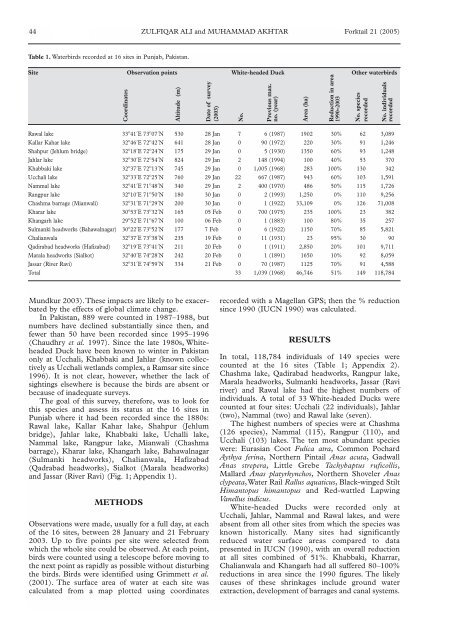
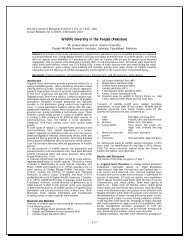
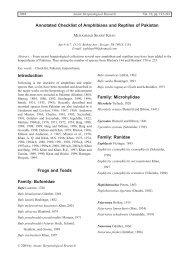

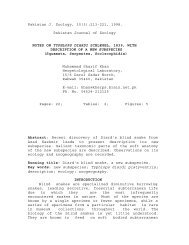


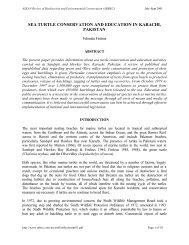
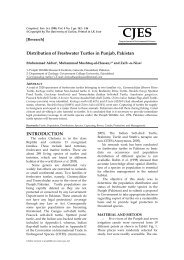
![Dureji (Ovis orientalis [vignei] blanfordi) - Wildlife of Pakistan](https://img.yumpu.com/11814520/1/190x245/dureji-ovis-orientalis-vignei-blanfordi-wildlife-of-pakistan.jpg?quality=85)
